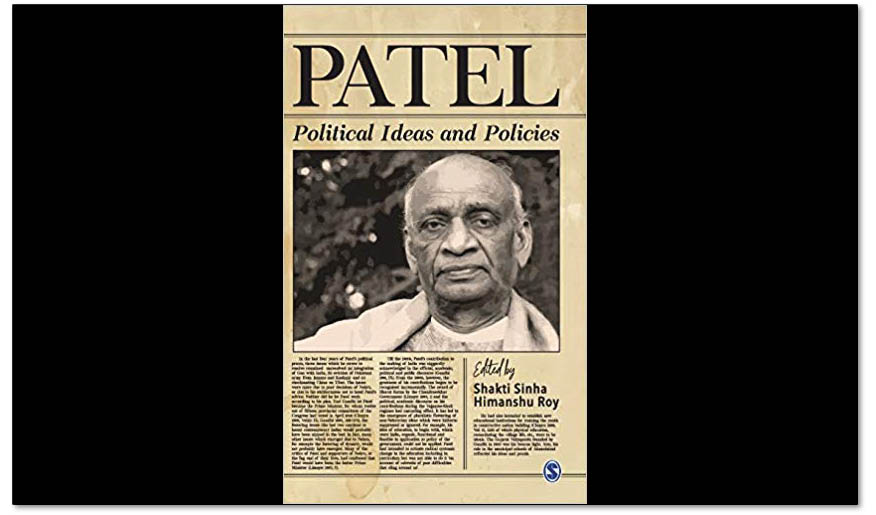The volume does a yeoman service by bringing studies on Patel, whose name is synonymous with the efforts that went into making a modern and integrated India.
Manipal: In the history of modern India and the efforts that went into building an independent and unified India, the contribution made by the Iron Man of India, Sardar Vallabhbhai Patel has been phenomenal. It is perhaps the right time to revisit his contributions and discover the significance of the larger ideals such as the concepts of liberal democracy, state and nationalism. There are differing perspectives on Sardar Patel. All these perspectives were built over the decades mainly from extreme biases and ideologies of communists, socialists and obviously Nehruvian. Hence, the edited volume, Patel: Political Ideas and Policies, edited by Shakti Sinha and Himanshu Roy has made a modest attempt in assessing and analysing different dimensions of Patel’s political ideas and his philosophy towards nation building.
The edited volume has brought out a good analysis on a number of areas including nationalism, governance issues and overall reorganisation of states in India after Independence. The contributions made by eminent scholars have covered the multifaceted dimensions of Patel’s contribution to India’s growth and development during its early years of Independence through his formidable role in the Constituent Assembly, transfer of power, integration of princely states with independent India, the territorial reorganisation of Indian states, administrative reforms, particularly the foundation of the Indian Civil Services, formation of the Planning Commission, India’s foreign policy and in formulating India’s economic policies.
In the introduction, “Making of a Gandhian Nationalist—Life and Times of Sardar Patel”, Shakti Sinha has analysed the transformation of Patel from a good pleader and barrister into becoming a mass leader and a nationalist. He has assessed the political milieu in which Patel grew in stature. Sinha has covered the circumstances in which Patel was forced to support the partition as the only way to end the Hindu-Muslim communal violence, and the efforts that he made to stabilise the tense situation post-partition. An important facet of Patel’s legacy was his role in building a permanent bureaucracy after Independence. Patel emphasised both political and economic freedom so that the people of India could enjoy the fruits of Swaraj (Independence) in the real sense.
In the chapter “Vallabhbhai Patel and Idea of Nationalism”, Dinesh Kumar Singh makes an attempt to analyse nationalism as the bedrock of Sardar Patel’s thinking and action. Patel’s idea of nationalism has been understood in the backdrop of the rise of the nationalist movement against the British imperial rule and the emergence of a newly independent India. For Patel, patriotism and nationalism were the foundation of the Indian State and democracy, stability, national security, pluralism and social justice were the cornerstone of nationalism. Patel was against using race and religion as the basis of building a nation state and considered civil liberties as the bedrock of a democratic polity. Instituting individual liberty and rights was also seen as an important element in the development of a nation. Patel’s idea of nationalism was also equally guided by an emphasis on communal harmony, truth and non-violence.
Himanshu Roy in his chapter “Patel’s Idea of Governance” has reflected on Patel’s political journey and his role in different capacities of administration and governance. Patel’s style of functioning, even while working at the municipal level, was seen to be guided by an understanding of people’s needs and finding solutions for them. For Patel, a strong Central government, well-equipped armed forces and economic stability were fundamentally important for proper administration. Patel also believed in the importance of disciplined and responsible citizenship. Roy in the chapter has highlighted Patel’s primary role in critical areas like transfer of power, partition of India and merger of the princely states, the making of the Constitution, the making of foreign and economic policy, reorganisation of the states and the arduous task of setting up a modern administrative structure.

In the chapter titled “Gujarat Sabha, Kheda Satyagraha and the Contesting Masculinities: Evaluating the Early Sardar Patel”, Balaji Ranganathan has delved into the early years of Patel’s life when he was emerging to be a significant organiser of the peasant causes and as a mass leader in his own right. According to Ranganathan, Patel’s sense of himself and his role during the freedom struggle was anchored within the principles of soul force or Satyagraha. Patel’s ingenuity and his efforts and vision to bring about inclusivity into the nationalist movement could be well inferred from his contributions towards a mass peasant mobilisation. Ranganathan has covered in detail the evolving personality of Sardar Patel from the days of his association with the Ahmedabad municipality and the full-blown movement in Kheda and Champaran, which gave rise to the Quit India Movement and the path of Swadeshi.
In the chapter titled “Patel and Minorities”, Niraj Kumar Jha has argued that Patel was thoroughly secular and was not against any community. Jha has explained in detail as to why Patel was an exponent of interfaith harmony and civic nationalism and what role Patel played in ensuring minority and community rights in the Indian Constitution as the Chairman of the Advisory Committee on Fundamental Rights, Minorities and Tribal and Excluded Areas of the Constituent Assembly. Jha has made an attempt to dispel the prevailing misperceptions regarding Patel’s approach to minorities and points out that Patel did not approve the demand for separate electorates for religious minorities, backward castes or tribes as he opposed the group identity replacing citizenship.
Neeraja Singh, in his chapter “Sardar Patel and the Left”, has very nicely elucidated the views that the Left, viz. the Communists and Socialists have propagated regarding Patel’s role in nation-building. For Patel, the freedom struggle should have experienced participation from across the political spectrum and not be divided among different political ideologies. Singh has contended that the Left were the major voice behind creating the misperceptions. Patel was of the opinion that parochial politics should not be played at a time when getting India liberated from the British yoke was the paramount objective. He favoured class collaboration instead of class conflict. According to Singh, no “ism” mattered more to Patel than nationalism and he approved or disapproved of any organisation based on its contribution to India’s national interest.
In the chapter titled “Patel, League and the Hindu Nationalists”, Bhuwan Kumar Jha has explained Patel’s sense and idea of nationalism, strong anti-Muslim League and anti-Jinnah positions and his leadership amidst growing communal tensions during the 1940s. Moreover, the author assessed Patel’s perception regarding the role and activities of the Hindu Mahasabha and the RSS, the rationale behind his differences with Mahatma Gandhi, his expectations from Indian Muslims post-partition and also his categorical views on secularism and community unity.
In the chapter titled “Trade Union Politics and Patel”, Kuver Pranjal Singh, while tracing the emergence of trade unions amidst the backdrop of industrialisation and the freedom movement, argued that Patel espoused bringing together the industrialists, workers and farmers for the cause of the freedom struggle. While he was against exploitation, he also did want to demonise the industrialists, since he aimed to build unity among different sections of society for the nationalist struggle. Singh has also explained as to why Patel emphasised the important role of the State in decision-making on Indian economy.
In the chapter titled “Patel and the Accession of Jammu and Kashmir”, Sonali Chitalkar and Rahul Chimurkar have highlighted the challenges that the integration of the princely states confronted during the territorial organisation of the newly independent India. Patel was tasked with the integration process through the instrument of accession. Chitalkar and Chimurkar have pointed out the challenges that emerged after the Kashmir issue was taken to the United Nations Security Council, contrary to Patel’s advice. According to the authors, Patel did not believe in halfway approaches and would have preferred the Indian Army to possibly go up to Muzaffarabad instead of halting at Uri or Poonch. Patel was very strong in his conviction.
Vinny Jain in her chapter titled “Patel: Reorganisation of States” has assessed the rigorous efforts that went into negotiating with the princely states. For Patel, the unity of India was paramount, and hence consensus with the princely states had to be struck. The new Indian states were to be brought under viable administrative units and they were to be organised within the Constitutional structure of India. Moreover, according to Jain, Patel favoured administrative convenience and historical-cultural ties to language as a basis of organisation of states.
In the chapter titled “State Building in India: Sardar Patel’s Reflections on Civil Services”, Karli Srinivasulu has analysed in detail as to how Patel was able to obtain Constitutional guarantees for the Indian Civil Services and helped build a professional administrative structure. According to Srinivasulu, Patel was instrumental in terms of striking a balance between the idealism of the nationalist movement and the pragmatism of statecraft.
In the chapter entitled “Economic Ideas of Sardar Patel”, Amit Dholakia has argued that not enough scholarly studies have been done on Patel’s economic ideas. For Patel, the topmost priority for India after attaining political independence was dealing with economic issues facing the country. According to him, political freedom had to be matched with economic freedom and Swaraj. Increasing India’s productive capacity was imperative in Patel’s vision of the Indian economic development, particularly to attain self-sufficiency in food production. Dholakia in the chapter has explained Patel’s views on the role of the government in the economic affairs of the country.
At a time when India’s rise is being keenly watched across the globe and India aspires to become a power of global reckoning, it is imperative to re-examine the legacy of leaders like Sardar Patel who had an instrumental role in India’s nation and state building. This edited volume does a yeoman service by bringing well researched studies on the multifaceted personality of Sardar Patel, and should be regarded as a welcome step towards initiating much more studies on a personality whose name is synonymous with the efforts that went into making a modern and integrated India. Such work will help explain the concept of nationalism in a far integrated fashion than having a fractured debate on nationalism.
Dr Arvind Kumar is Professor and Head, Department of Geopolitics and International Relations, and Director, Study Abroad Program at Manipal Academy of Higher Education

